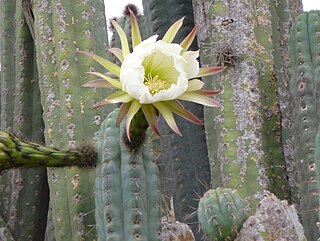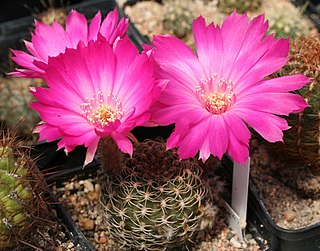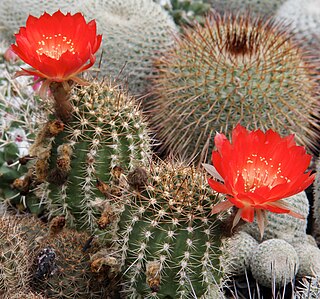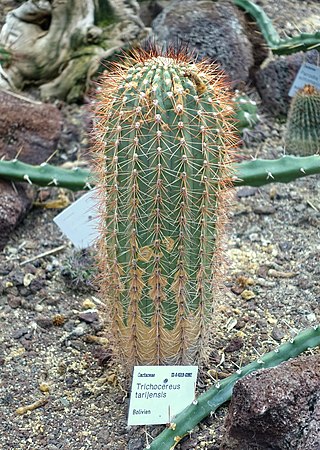
Cleistocactus strausii, the silver torch or wooly torch, is a perennial flowering plant in the family Cactaceae. It is native to mountainous regions of Department Tarija, Bolivia, at 1,500–3,000 m (4,921–9,843 ft).

Weingartia is a genus in the family Cactaceae, with species native to Bolivia and Argentina. Molecular phylogenetic evidence suggests that it may be distinct from Rebutia. It is treated as a synonym of that genus by Plants of the World Online as of September 2023, but recognized as an alternative generic name in the third edition of the CITES Cactaceae Checklist. It may also be treated as Rebutia subg. Weingartia.

Yungasocereus inquisivensis is a species of cactus native to Bolivia; it is the sole member of the genus Yungasocereus.

Echinopsis lageniformis, synonyms including Echinopsis scopulicola and Trichocereus bridgesii, is a cactus native to Bolivia. It is known as the Bolivian torch cactus. Among the indigenous populations of Bolivia, it is sometimes called achuma or wachuma, although these names are also applied to related species such as Trichocereus macrogonus which are also used for their psychedelic effects.

Selenicereus grandiflorus is a cactus species originating from the Antilles, Mexico and Central America. The species is commonly referred to as queen of the night, night-blooming cereus, large-flowered cactus, sweet-scented cactus or vanilla cactus. The true species is extremely rare in cultivation. Most of the plants under this name belong to other species or hybrids. It is often confused with the genus Epiphyllum.

Leucostele atacamensis (cardón) is a species of cactus from Chile, Argentina and Bolivia. The wood of this species can be used in building and in making furniture.

Pachycereus pecten-aboriginum is a columnar cactus plant native to Mexico. They can grow up to 15 m (49 ft) high. The trunk of this species is 1.2 to 5.0 m tall and the fruits are large and burr-like. The specific name, pecten-aboriginum, is from the Latin, and means "native combs". It was inspired by the use of the fruits as hair combs.

Echinocereus stramineus is a species of cactus, wih stramineus meaning made of straw. There are various common names such as strawberry cactus, porcupine hedgehog cactus, straw-color hedgehog, and pitaya. The straw-colored spines distinguishes this particular plant from other Echinocereus. The aged spines may turn white in color and are very fragile.

Lobivia backebergii is a species of flowering plant in the cactus family Cactaceae, native to eastern Bolivia and southern Peru.

Leucostele terscheckii, commonly known as the cardon grande cactus or Argentine saguaro, is a large cactus native to South America and popular in cultivation.

Cereus jamacaru, known as mandacaru or cardeiro, is a cactus native to central and eastern Brazil. It often grows up to 6 metres high.

Lobivia ancistrophora is a species of cactus. It has a globular shape, few spines, with large, white flowers attached to long, green tubes. It occurs in Bolivia, at altitudes of 600–1800 metres. Under its synonym Echinopsis ancistrophora it has gained the Royal Horticultural Society's Award of Garden Merit.

Lobivia bridgesii, is a species of Lobivia found in Bolivia.

Lobivia ferox, is a species of Lobivia found in Bolivia and Argentina.

Lobivia hertrichiana, is a species of Echinopsis found in Bolivia and Peru.

Lobivia pentlandii, is a species of Lobivia found in Bolivia and Peru.

Soehrensia tarijensis, is a species of Soehrensia, in the cactus family. It is native to Bolivia and northwestern Argentina.

Lobivia schieliana, is a species of Lobivia found in Bolivia and Peru.

Lobivia tiegeliana, is a species of Lobivia found in Argentina and Bolivia.

Polaskia chichipe is a succulent cactus native to a small area of mountains of northern Oaxaca and southern Puebla, Mexico. It grows in xerophytic shrubland between 1,600 and 2,300 meters above sea level.




















